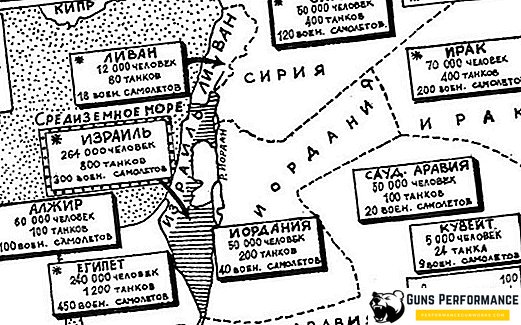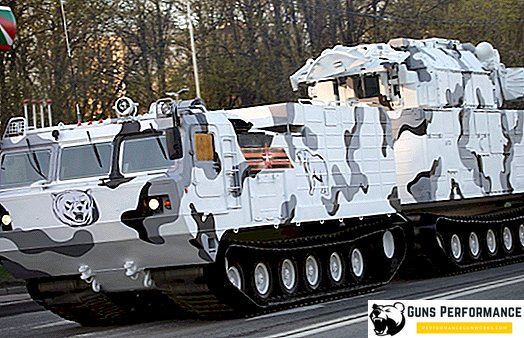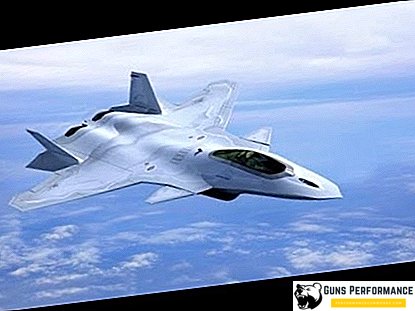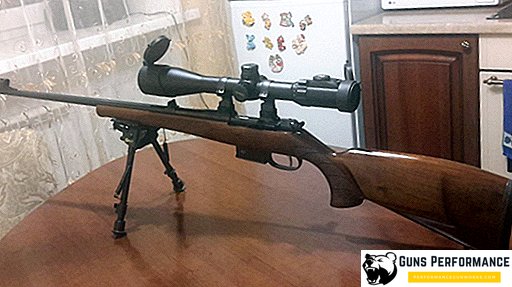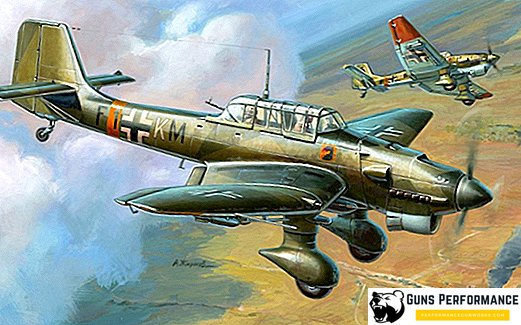
Among the fairly extensive fleet of Nazi Germany during the Second World War, a dive bomber Junkers Ju-87 is perhaps the most famous and remarkable. This aircraft has long been the same symbol of the great war, as well as the T-34 tank, Il-2 attack aircraft or the B-17 American heavy bomber.
The Yu-87 dive bomber is strongly associated with the first years and months of the Second World War, it is closely associated with the victories of Germany in 1939-1942, with the implementation of the German concept of blitzkrieg. But for hundreds of thousands of citizens of Spain, Poland, France, the Balkans and the Soviet Union, this aircraft became a symbol of grief, fear and destruction.
The chilling wail of siren U-87 is one of the most vivid memories of people who survived that terrible war. Anyone who has heard it at least once will hardly be able to forget until death. For non-retractable landing gear, Soviet soldiers called the Yu-87 dive-bomber as a "laptechnik" or "lapotnik." In Germany, this aircraft received the designation Ju-87 Stuka (from the German word Sturzkampfflugzeug, which means a diving bomber).
Despite the very mediocre performance characteristics, this aircraft was one of the most effective combat vehicles of the Luftwaffe. In the very appearance of the bomber there was something ominous, resembling a bird of prey: non-retractable landing gear were similar to the released claws, and the wide radiator of the car - to the gaping mouth. All this, together with the famous howl of the siren, produced the strongest psychological effect of the enemy soldiers, on whose heads the U-87 with its deadly precision dropped its bombs.
The first flight of the Yu-87 "Stuka" made in September 1935, the aircraft was commissioned in 1936, its mass production continued until almost the very end of the war. In total, about 6.5 thousand units of this aircraft were manufactured.
The combat debut of the Yu-87 took place during the Spanish Civil War; this aircraft participated in all the battles of World War II that took place on the European theater of military operations. However, the effectiveness of the dive bombers at the final stage of the war fell sharply: the Germans lost air supremacy and the low-speed Ju-87 Stuka became easy prey for the Allied fighters. At the end of the war, the Germans began to replace the "Stuka" with assault modifications of the Fw-190A fighter.
The Yu-87 was constantly improved: over the years of mass production, about ten modifications of this dive-bomber were created. Based on the Ju-87 dive-bomber, several variants of attack aircraft were developed. In addition to Germany, this machine was in service with the Air Forces of Italy, Bulgaria, Hungary, Croatia, Romania, Japan and Yugoslavia (after the war).

History of creation
Almost immediately after they came to power, the Nazis took up the creation of full-fledged armed forces, and the revival of the Air Force became one of their main priorities. The problem was that after the First World War, Germany was severely restricted.
The Nazi leaders initially feared to openly violate them, so until 1935 the development of new combat aircraft were kept secret. After the official announcement of the creation of the Air Force, Germany began to rapidly increase the power of its air fleet.
Before the military leadership of the Third Reich, the question arose of how to make front-line aviation the most effective. The direct air support of the ground forces on the battlefield played a very important role in the implementation of the concept of blitzkrieg, so this issue received much attention. In the USSR, from the beginning of the 1930s, an armored attack aircraft was developed for these purposes, which subsequently led to the creation of the famous IL-2 "flying tank". In Germany and the United States went a little different way, they were engaged in the creation of dive bombers.
Since its inception, the main problem of bomber aircraft has been bombing accuracy. Even the creation of heavy machines such as "Ilya Muromets" did not change the situation too much: because of the low accuracy, bombers often inflicted only moral damage on the enemy. However, the pilots noticed that the dive bombing strikes provide much greater accuracy than normal horizontal bombing. After the war, military theorists of the leading aviation powers of that time paid attention to this tactical device.
However, the creation of an effective dive bomber was a very difficult task. During the exit from the dive, the aircraft design was subjected to significant overloads (up to 5g), which only a very strong machine could withstand. To perform its functions, the dive-bomber must be equipped with powerful wing mechanization and air brakes. Designers also needed to think about an automatic system for withdrawing a bomber from a peak and devices that would deflect bombs from the plane of the propeller of the aircraft at high dive angles. Since the dive-bomber most often operates at low altitudes, his crew needed reliable armor protection.

The most important role in the creation of the German dive-bomb was played by the pilot-pilot (62 victories) of the First World War Ernst Udet. He was a squadron commander in the regiment of the legendary Manfred von Rihtgofen and an intimate friend of the Third Reich Aviation Minister Hermann Göring. It was the latter circumstance that allowed Udet to actively influence the development of the German aviation industry in the 30s-40s.
Udet met the newest dive bomber in the USA and privately bought two cars. Later he personally demonstrated to the Luftwaffe leadership the possibilities of dive bombing. The new tactics had many opponents, the most ardent of which was Wolfram von Richthofen - the nephew of the famous ace and the future commander-in-chief of the German air fleet.
Udet was invited to serve in the Luftwaffe, received the rank of colonel and almost immediately engaged in promoting the project of a diving bomber for the German army.
Back in 1932, the German Ministry of Aviation announced a competition for the creation of a diving bomber, which was to be held in two stages. At the first of these (the so-called immediate program), German manufacturers had to develop a biplane-dive bomber who would replace the outdated Non-50 aircraft. From the new aircraft did not require outstanding performance, but from the designers expected quick results. At the next stage of the competition (it began in January 1935), its participants had to offer the customer a modern dive-bomber plane, with high performance, equipped with air brakes.
The main competition was attended by the most eminent German aircraft manufacturers: "Arado", "Henkel", "Blom and Foz" and "Junkers". Among the applicants in the most advantageous position was the company "Junkers", which began to develop attack aircraft in 1933. Some historians even believe that the competition was an ordinary formality, since the task was practically developed for the future Ju-87.

Work on the future of the Yu-87 was carried out by a group of designers under the leadership of German Polman. For the first time, the dive bomber rose to the sky in September 1935.
The prototype of the Yu-87 was not very different from the car, which was later launched into the series: it was a two-metal all-metal monoplane equipped with a wing with a characteristic inverted gull-type fracture. In order not to weaken his design, Polman decided to abandon cuts for cleaning the chassis and made it non-retractable. And to improve the aerodynamics of the car chassis were enclosed in fairings.
The designers of the "Junkers" turned out to be a very good airplane: strong, reliable, with good handling and excellent visibility from the cockpit. The dive-bomber had powerful wing mechanization in order to avoid bombs getting into the propeller plane. A simple and reliable frame structure was installed on it to divert the bombs to a safe distance from the vehicle.

The first aircraft was equipped with a two-tail unit and the British Rolls-Royce Kestrel engine was installed on it. But the following prototypes have already been equipped with much more powerful German motors Jumo 210A. During one of the first flights at the exit from the peak, the tail of the bomber could not stand the load and collapsed, as a result of the catastrophe, the crew died.
In March 1936, comparative tests of dive bombers, represented by the participating companies, began at the Rekhlin airfield. In the final part of the aircraft came out, developed by the "Junkers" and "Henkel".
The winner was recognized Ju-87, although in terms of basic parameters it was inferior to Not-118. The head of the technical department, von Richthofen, ordered the work on the Ju-87 to be stopped, but the very next day Ernst Udet was removed from his post. But this was not the end of this intriguing story. A few days later Udet (already the head of the technical management of the Luftwaffe) himself raised the non-118 into the sky. During the dive, the strongest vibration began, which completely destroyed the tail section of the aircraft. Udet miraculously survived, he escaped by jumping with a parachute. Naturally, this episode put an end to the promising career of the Ne-118 and was the beginning of the dizzying takeoff of the Ju-87.
Flight tests of the Ju-87 continued until the end of 1936. In the same year, the first pre-series dive bomber came off the assembly line, and in early 1937, the Junkers company finally received a long-awaited order for the first batch of production aircraft.

Description of construction
The Ju-87 dive bomber is an all-metal single-engine low-wing with a non-retractable landing gear. The fuselage is a Ju-87 type semi-monocoque oval section. The crew consisted of two people: a pilot and a gunner-radio operator.
The cockpit was located in the central part of the aircraft, they were closed by a common lantern, which could be dropped emergency. In the rear of the cab was a machine gun (MG 15). In the fuselage of the dive bomber, there was a glazed hatch covered with a metal lid on top. Through it, the pilot could select targets and accurately determine the time when the dive began. Between the cockpits of the pilot and the gunner-radio operator was a shortwave radio station.
Ju-87 had a trapezoid wing with rounded edges, consisting of a center section and two consoles. His power frame consisted of ribs, spars and working plating. The wing of the Ju-87 was made according to the “reverse gull” scheme, which made it possible to reduce the weight and size of the non-retractable chassis.

The wing mechanization consisted of slotted ailerons and flaps. An aerodynamic brake was installed under each of the wing consoles, which was used to reduce the aircraft’s dive speed. It was a metal plate with a gap in the middle. The brake flaps were controlled using the Ahfanggerat dive machine. The brake flaps and flaps were controlled using a hydraulic system.
In the center section of the wing is also located very bulky fuel tanks.
The Ju-87 dive-bomber was equipped with a water-cooled Jumo 211 engine, which, depending on the modification of the machine, had different power. The plane had a wooden three-bladed propeller with a variable pitch (in the later versions they installed a metal one). The automatic pitch control and motor control were combined into a single system with the automatic dive, which also controlled the fuel supply, opening and closing of the radiator leaves. The automatic dive became the most important innovation of the Ju-87, in many respects ensuring its effectiveness. He greatly simplified the work of the pilots, allowing you to fully concentrate on bombing. Later, an altitude monitor was included in the scheme, so the "thing" was derived from a dive, regardless of whether the bomb was dropped.

The U-87 had a single all-metal tail assembly with a subosseous stabilizer. Each elevator had two trimmers, which were connected to a dive machine. Adjustment of stabilizers was possible only with flaps.
The bomber had a tricycle non-retractable landing gear with oil-pneumatic shock absorption. Its design allowed the pikeman to use ground airfields located near the front line. On the Ju-87 it was possible to install skis.
The fuel system consisted of two protective tanks located in the center section of the wing, with a capacity of 250 liters.
The water cooling radiator was located in the nose of the car, in the tunnel under the engine.
The Ju-87 dive bomber was armed with three 7.92-mm machine guns: two stationary MG-17s were placed in wing consoles, another MG-17 was installed in the gunner’s cabin and was used to protect the rear hemisphere and shelling the ground during an exit from a dive.
The bombing load of the diving bomb was 1 thousand kg, the car had three suspension points: under the fuselage and under the wing consoles. During the dive, a special H-shaped fork removed the central bomb from the propeller.
The armament of the Ju-87 was somewhat changed in different versions. For example, the Yu-87 attack aircraft (modification Ju-87G) was armed with two 37-mm cannons.
Modifications
During the period of mass production, more than ten modifications of the Ju-87 dive-bomber were developed. Usually in the historical literature, modifications from A to B and R are attributed to the first generation of dive bombers. The second is represented by aircraft of the D and F series, and the U-87 of the G. modifications is considered to be the third.

Ju-87A. This is the first modification of the aircraft, equipped with a Jumo-210 engine (680 hp.). This engine power was clearly insufficient, the plane could take on board only one 500-kilogram bomb, and then only if there was no gunner-radio operator in the cockpit. Flight range with a full combat load was minimal. A-Series dive bombers took part in the Spanish Civil War, these planes were in service with the Condor Legion. Production of the Yu-87 Series A was already discontinued in early 1938.
Ju-87B. This modification of the aircraft was equipped with a Jumo-211 engine (1140 hp). The dive-bomber could take on board a bomb with a caliber of 1 thousand kg, but without a gunner-radio operator and for short distances. The aircraft was improved radio equipment, installed a third machine gun in the left wing. This modification is considered the main for the initial period of the war.
Ju-87C. Deck modification dive bombers, was developed for the German aircraft carrier "Graf Zeppelin", which was never built. The aircraft of this series had a folding wing, a brake hook, a carrier for a catapult, and a rescue boat. In case of an emergency landing on the water, their chassis could be fired. A total of 10 cars of this series were built. After the start of the Polish campaign, they were all converted to modification B and sent to the Eastern Front.
Ju-87D. This modification of the aircraft appeared after a year of war, its design took into account the experience gained by German pilots in Poland, France, during the battle for Britain and in the first months of the war with the Soviet Union. Production of aircraft series D began in September 1941. The Luftwaffe leadership realized that the defensive armament installed on the Yu-87 was not enough to protect the aircraft from fighters, and the existing booking could not effectively withstand anti-aircraft fire. Does not meet the requirements of the time and power plant.
Therefore, the dive bomber has undergone significant modernization. A new engine with a capacity of 1420 liters was installed on the car. with., the booking of the aircraft was significantly strengthened. The MG-15 machine gun in the rear turret was replaced with a double-barreled MG-81. Later, the D-series aircraft received a new, more advanced chassis.
The wooden screw was not well suited for the conditions of the Russian winter, it cracked from the cold. Therefore, it was replaced with a metal one, a new Revi C / 12C sight was also installed on the aircraft, the design of the cockpit canopy was altered, and fuel reserves were increased.
The modification of the Ju-87D is the most numerous. The baptism of this car occurred in early 1942 near Leningrad, its production continued until the end of 1944. It is usually divided into several series: D-1, D-3, D-4 and D-5, D-6 and D-7.
By 1943 it became clear that an attack aircraft was needed to support the ground forces. It was created on the basis of the modification Ju-87D. For this, the armor protection of the cabin and the engine was strengthened, and the famous sirens were removed from the aircraft. On the night version of the aircraft were installed flame arresters and equipment for flying in the dark.
Quite interesting is the series Ju-87D-4, it was a coast-based torpedo carrier. The car did not find its use, was converted into an attack aircraft and sent to the Eastern Front.
Ju 87D-5 - this is another "assault" modification, created in early 1943. The aircraft of this series had a larger wingspan and more powerful small arms: in the wing consoles, instead of machine guns, MG 151/20 guns were installed. Series D-5 was quite popular, until September 1944, it was released almost 1.5 thousand cars.
Также существовали две специализированные "ночные" версии модификации Ju 87 - D-7 и D-8. В их основе лежала "штурмовая" серия D-3. На эти самолеты устанавливался пламегаситель, а также дополнительное радиооборудование.
Ju-87E. Это палубная модификация пикировщика, она так и не пошла в серию.

Ju-87G. "Штурмовая" модификация самолета, созданная специально для борьбы с бронетехникой противника.
Со временем ситуация на Восточном фронте сильно изменилась и немецкое командование уже не могло так эффективно использовать Ju 87, как это было в первые годы войны. Начиная с 1942 года для немцев наибольшую проблему стали составлять советские танки, количество которых постоянно увеличивалось. Поэтому на базе пикировщика был создан штурмовик, основной задачей которого стало уничтожение советской бронетехники.
Бомбы были малоэффективны против советских средних и тяжелых танков (Т-34 и КВ), поэтому на самолет были установлены мощные авиационные пушки BK 37 (37 мм). Они были установлены под консолями крыла. Магазин каждой пушки вмещал шесть бронебойных снарядов с сердечником из карбида вольфрама.
Массовое переоборудование самолетов модификаций D-3 и D-5 в противотанковый штурмовик началось в конце 1943 года. Самолеты серии G были весьма эффективным средством борьбы против танков: мощное вооружение, хорошая управляемость самолета и его невысокая скорость позволяли немецким летчикам атаковать бронированные машины с наименее защищенной стороны. На счету 4-й авиагруппы под командованием знаменитого немецкого аса Ганса-Ульриха Руделя числилось более пятисот уничтоженных советских танков. 37-мм пушка также позволяла Ju-87G успешно бороться с советскими бронированными штурмовиками Ил-2.

Ju-87R. Модификация с увеличенным радиусом действия. На эти самолеты были установлены дополнительные баки по 150 литров каждый. Они располагались в крыльях. Также была предусмотрена возможность использования подвесных баков. Увеличенный запас топлива уменьшил боевую нагрузку самолета до 250 кг. Пикировщики модификации R планировали использовать в качестве дальнего противокорабельного самолета.
Ju-87H. Учебно-тренировочная модификация пикирующего бомбардировщика, она не имела вооружения.
Как пикировала "Штука"
Пикирование на цель начиналось на высоте 4600 метров. Пилот выбирал цель, используя для этого наблюдательный застекленный люк, находящийся в полу кабины. Затем он убавлял газ, выпускал аэродинамические тормоза и, переворачивая машину на 180 градусов, отправлял ее в пике под углом 60-90 градусов. С помощью специальной шкалы, нанесенной на фонарь кабины, пилот мог контролировать угол пикирования.
На высоте 400-450 метров происходил сброс бомб, после чего в действие вступал автомат пикирования, выводивший самолет в нормальный горизонтальный полет. Во время бомбометания летчик мог испытывать перегрузки до 6g.

Затем убирались воздушные тормоза, шаг винта приводился в режим горизонтального полета, дроссель открывался и пилот принимал управление на себя. В точности бомбометания с пикирования Ju-87 превосходил советский пикировщик Пе-2. Немецкий самолет сбрасывал бомбы с меньшей высоты (менее 600 метров), Пе-2 обычно производил бомбометание примерно на километровой отметке. Кроме того, Ju-87, обладая меньшей скоростью, давал пилоту больше времени на прицеливание. Хотя, главной причиной высокой эффективности "штуки" был отличный уровень подготовки немецких пилотов.
Итальянские пилоты Ju-87 для нанесения ударов по кораблям противника использовали несколько другую тактику: они пикировали под меньшими углами (40-50 градусов), но при этом не использовали воздушные тормоза. В этом случае машина постоянно набирала скорость, что усложняло работу вражеских зенитчиков.
Эффективность и боевое применение
Мало какой самолет периода Второй мировой войны вызывал столько ожесточенных дискуссий, как немецкий бомбардировщик Ju-87 Stuka. Этот пикировщик нередко называют самым эффективным оружием Люфтваффе, другие же авторы нещадно критикуют его за тихоходность и высокую уязвимость для истребителей противника.
В советской историографии чаще всего придерживались последнего мнения: Ю-87 нещадно ругали, зато всячески превозносили достоинства советского "летающего танка" Ил-2. Немецкую машину обычно описывали, как самолет чистого неба, эффективный только там, где нет зенитного огня. Подчеркивался тот факт, что "лаптежники" быстро растеряли весь свой смертоносный шарм, после того как в Красной армии появилось достаточно средств ПВО и истребителей.

Действительно, потери Ju-87 во второй половине войны значительно возросли, однако они не были так катастрофичны, как описывают советские учебники. Вот, например, данные о потерях 2-й и 77-й пикировочных эскадр во время операции "Цитадель" (битва на Курской дуге). Источник информации - отчет о потерях службы генерал-квартирмейстера Люфтваффе.
За первый день операции (5 июля), совершив 1071 вылетов, оба подразделения потеряли всего лишь четыре самолета. 7 июля немецкими пилотами было сделано 746 вылетов, что привело к потере одного бомбардировщика. Правда, затем потери стали выше: на один сбитый самолет приходилось 116-117, а потом и 74-75 вылетов.
В среднем же во время операции "Цитадель" на один потерянный пикировщик Ju-87 приходилось примерно 153 боевых вылетов. Тогда как на один сбитый советский штурмовик Ил-2 из состава 2-й воздушной армии, которая находилась на этом же участке фронта, приходилось всего лишь 16-17 вылетов. Получается, что уровень потерь советских самолетов был почти на порядок выше. Следует отметить, что части Воронежского фронта, против которых действовали немецкие подразделения, были достаточно насыщены зенитными орудиями и прикрыты истребительной авиацией.
Впервые немецкие пикировщики были применены во время гражданской войны в Испании. Эти машины были на вооружении легиона "Кондор". Так что обкатка и усовершенствование Ju-87 происходило в реальных боевых условиях.

Ju-87 блистал в начальный период войны: он показал себя как суперэффективное оружие во время вторжения гитлеровцев в Польшу, Францию и Норвегию. Во время польской кампании немцы потеряли всего лишь 31 самолет. Битва за Британию впервые показала немцам уязвимость этой машины для истребителей противника: из-за слишком больших потерь использование пикировщиков в этой операции было приостановлено.
В южной части европейского ТВД в сражениях с теми же англичанами за Крит и Мальту "штука" оказалась куда более эффективна, потому что здесь ей не противостояло такое количество истребителей.
Ju-87 прекрасно показал себя на Восточном фронте в первые годы войны. В этот период применение пикировщиков часто решало исход тех или иных операций. "Лаптежники" сыграли решающую роль в окружении советской группировки под Вязьмой и ее последующем разгроме. Огромный вклад Ju-87 внесли в катастрофический для Красной армии исход Харьковской операции в 1942 году. Непрерывные удары пикировщиков срывали атаки советских войск под Ленинградом и Ржевом.
Пикировщик Ju-87 был довольно эффективным противотанковым средством. Самым результативным пилотом "штуки" в годы Второй мировой войны был Ганс-Ульрих Рудель. На его счету около 2 тыс. единиц уничтоженной бронетехники противника (в основном советской), в том числе и более пятисот танков (правда, много историков сомневается в этих цифрах). Кроме того, Рудель уничтожил несколько кораблей, включая и линкор "Марат" на рейде Кронштадта.

Однако с ростом мощи советских ВВС он стал нести слишком большие потери и, в конце концов, был заменен штурмовиком Fw-190A.
Specifications
| Modification | Ju-87А |
| Wingspan, m | 13,6 |
| Length m | 10,78 |
| Height, m | 3,89 |
| Wing area, m2 | 31,9 |
| Weight, kg | |
| empty aircraft | 2300 |
| normal takeoff | 3402 |
| engine's type | Junkers Jumo-210D |
| Power, hp | 680 |
| Max. скорость , км/ч | 320 |
| Крейсерская скорость , км/ч | 275 |
| Max. скорость пикирования, км/ч | 450 |
| Practical range, km | 1000 |
| Practical ceiling, m | 7000 |
| Crew | 1-2 |
| Armament: | 7,9-мм пулемет МG-17 и один 7,9-мм пулемет МG-15; Max. бомбовая нагрузка - 500 кг (без стрелка-радиста) |



